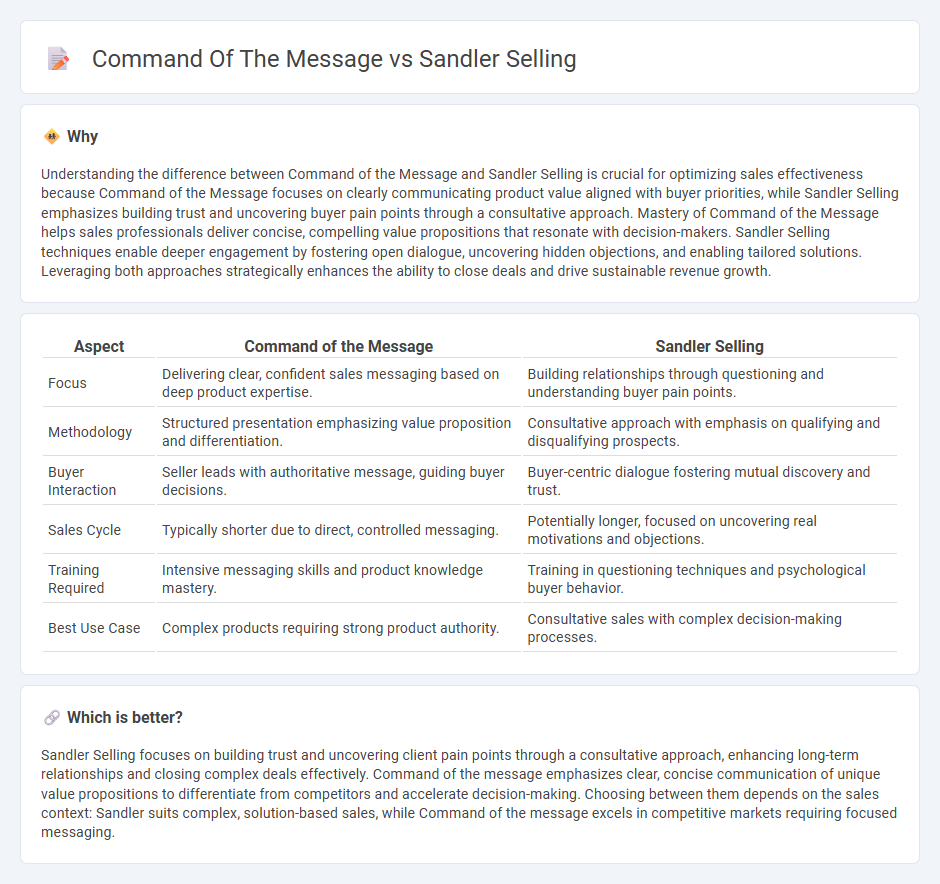
Command of the message focuses on delivering a clear, compelling value proposition that resonates with the buyer's needs, emphasizing precise communication and confidence. Sandler Selling employs a consultative, question-driven approach to uncover client pain points and build trust through reinforcement and agreement. Explore how mastering these methodologies can transform your sales effectiveness and close rates.
Why it is important
Understanding the difference between Command of the Message and Sandler Selling is crucial for optimizing sales effectiveness because Command of the Message focuses on clearly communicating product value aligned with buyer priorities, while Sandler Selling emphasizes building trust and uncovering buyer pain points through a consultative approach. Mastery of Command of the Message helps sales professionals deliver concise, compelling value propositions that resonate with decision-makers. Sandler Selling techniques enable deeper engagement by fostering open dialogue, uncovering hidden objections, and enabling tailored solutions. Leveraging both approaches strategically enhances the ability to close deals and drive sustainable revenue growth.
Comparison Table
| Aspect | Command of the Message | Sandler Selling |
|---|---|---|
| Focus | Delivering clear, confident sales messaging based on deep product expertise. | Building relationships through questioning and understanding buyer pain points. |
| Methodology | Structured presentation emphasizing value proposition and differentiation. | Consultative approach with emphasis on qualifying and disqualifying prospects. |
| Buyer Interaction | Seller leads with authoritative message, guiding buyer decisions. | Buyer-centric dialogue fostering mutual discovery and trust. |
| Sales Cycle | Typically shorter due to direct, controlled messaging. | Potentially longer, focused on uncovering real motivations and objections. |
| Training Required | Intensive messaging skills and product knowledge mastery. | Training in questioning techniques and psychological buyer behavior. |
| Best Use Case | Complex products requiring strong product authority. | Consultative sales with complex decision-making processes. |
Which is better?
Sandler Selling focuses on building trust and uncovering client pain points through a consultative approach, enhancing long-term relationships and closing complex deals effectively. Command of the message emphasizes clear, concise communication of unique value propositions to differentiate from competitors and accelerate decision-making. Choosing between them depends on the sales context: Sandler suits complex, solution-based sales, while Command of the message excels in competitive markets requiring focused messaging.
Connection
Command of the message enhances the effectiveness of Sandler Selling by ensuring sales professionals communicate the value proposition clearly and confidently, addressing customer pain points precisely. Mastery in message delivery aligns with Sandler's emphasis on understanding buyer motivations and fostering honest dialogue, which builds trust and accelerates decision-making. This synergy between strong messaging and the Sandler methodology leads to higher conversion rates and stronger client relationships.
Key Terms
**Sandler Selling:**
Sandler Selling emphasizes a consultative sales approach centered on uncovering customer pain points and fostering trust through open communication and qualification techniques. This method prioritizes understanding the prospect's challenges to tailor solutions effectively, leading to higher conversion rates and stronger client relationships. Discover how Sandler Selling can transform your sales strategy and drive more consistent results.
Up-Front Contract
Sandler Selling emphasizes establishing an Up-Front Contract to set clear expectations and mutual agreement at the start of sales interactions, ensuring alignment and trust between buyer and seller. Command of the Message, while focused on delivering consistent value propositions tailored to customer needs, integrates the Up-Front Contract to clarify the buying process steps upfront and enhance communication efficiency. Explore deeper strategies for mastering the Up-Front Contract to optimize your sales dialogue and improve close rates.
Pain Funnel
Sandler Selling emphasizes uncovering client pain through a structured Pain Funnel to identify underlying challenges and motivate buying decisions. Command of the Message enhances this approach by providing tailored messaging that aligns precisely with the pain points uncovered, improving communication clarity and value delivery. Explore how integrating these methodologies amplifies sales effectiveness and deepens customer engagement.
Source and External Links
Sandler Sales Methodology: 7 Steps to Sales Success - The Sandler sales methodology focuses on building a consultative partnership with buyers through seven key steps: Bonding and rapport, Up-front contracts, Pain, Budget, Decision, Fulfillment, and Post-sell, emphasizing mutual trust for long-term business success.
What is the Sandler sales methodology? (With examples) - Sandler selling is a structured B2B sales approach involving qualifying leads and guiding prospects through a consultative process with seven stages called the Sandler submarine, improving profit margins and fitting complex sales cycles.
The Sandler Selling System: A Step-by-Step Guide - This methodology is easy to learn, improves deal-closing rates through upfront contracts and rapport-building, boosts customer retention and sales margins, and offers greater forecast predictability by focusing on transparency and qualification.
 dowidth.com
dowidth.com